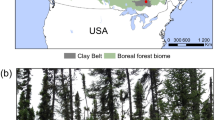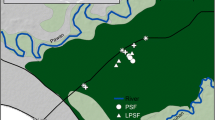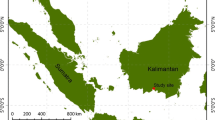Abstract
Forested peatlands are widespread in the boreal landscape, but their role as carbon (C) pools remains poorly documented. In this study, we investigated the long-term C sequestration function of boreal forested bogs in relation to fires in eastern Canada. Results show that the forested peatlands comprise substantial peat C mass reaching values similar to open peatlands. At the six studied peatland sites, the amount of C stored in peat (62–172 kg C m−2) exceeds substantially the aboveground tree biomass C (1.5–5.3 kg C m−2). The C locked up in live conifers on the peatlands corresponds only to a small fraction of the C stored in peat (1–6%). In comparison, the shallow organic layer (≤ 30 cm) in the adjacent paludifying stands store 10.8 kg C m−2 on average, which is about twice as much C as the live conifers. Long-term apparent C accumulation rates are relatively low in the studied forested bogs (mean: 15.9 g C m−2 y−1), suggesting that these ecosystems have lower C sequestration potential than non-forested bogs over millennia. The charcoal data suggest that past local fires reduced C sequestration rates, but these peatlands burn much less frequently than upland forests and are thus more efficient long-term C stores. This study highlights the importance of boreal forested peatlands as C reservoirs and helps understanding how fires, logging and climate change can affect their C sequestration function. These findings have important implications for ecosystem management that aims at maximizing C sequestration at the landscape level to mitigate climate change.







Similar content being viewed by others
References
Bauer IE, Bhatti JS, Swanston C, Wieder RK, Preston CM. 2009. Organic matter accumulation and community change at the peatland–upland interface: Inferences from 14C and 210Pb dated profiles. Ecosystems 12:636–53.
Benscoter BW, Wieder RK. 2003. Variability in organic matter lost by combustion in a boreal bog during the 2001 Chisholm fire. Canadian Journal of Forest Research 33:2509–13.
Benscoter BW, Thompson DK, Waddington JM, Flannigan MD, Wotton BM, De Groot WJ, Turetsky MR. 2011. Interactive effects of vegetation, soil moisture and bulk density on depth of burning of thick organic soils. International Journal of Wildland Fire 20:418–29.
Bergeron Y, Gauthier S, Flannigan M, Kafka V. 2004. Fire regimes at the transition between mixedwood and coniferous boreal; forest in northwestern Quebec. Ecological Society of America 85:1916–32.
Bhatti JS, Errington RC, Bauer IE, Hurdle PA. 2006. Carbon stock trends along forested peatland margins in central Saskatchewan. Canadian Journal of Soil Science 86:321–33.
Blaauw M, Christen JA. 2011. Flexible paleoclimate age-depth models using an autoregressive gamma process. Bayesian Analysis 6:457–74.
Blodau C, Basiliko N, Moore TR. 2004. Carbon turnover in peatland mesocosms exposed to different water table levels. Biogeochemistry 67:331–51.
Camill P, Barry A, Williams E, Andreassi C, Limmer J, Solick D. 2009. Climate-vegetation-fire interactions and their impact on long-term carbon dynamics in a boreal peatland landscape in northern Manitoba, Canada. Journal of Geophysical Research: Biogeosciences 114(G4).
Chambers FM, Beilman DW, Yu Z. 2011. Methods for determining peat humification and for quantifying peat bulk density, organic matter and carbon content for palaeostudies of climate and peatland carbon dynamics. Mires and Peat 7:1–10.
Charman DJ, Amesbury MJ, Hinchliffe W, Hughes PD, Mallon G, Blake WH et al. 2015. Drivers of Holocene peatland carbon accumulation across a climate gradient in northeastern North America. Quaternary Science Reviews 121:110–19.
Fenton N, Beland C, De Blois S, Bergeron Y. 2007. Sphagnum establishment and expansion in black spruce (Picea mariana) boreal forests. Canadian Journal of Botany 85:43–50.
Flannigan MD, Cantin AS, De Groot WJ, Wotton M, Newbery A, Gowman LM. 2013. Global wildland fire season severity in the 21st century. Forest Ecology and Management 294:54–61.
Frolking S, Roulet NT. 2007. Holocene radiative forcing impact of northern peatland carbon accumulation and methane emissions. Global Change Biology 13:1079–88.
Garneau M, van Bellen S, Magnan G, Beaulieu-Audy V, Lamarre A, Asnong H. 2014. Holocene carbon dynamics of boreal and subarctic peatlands from Québec, Canada. The Holocene 24:1043–53.
Hua Q, Barbetti M, Rakowski AZ. 2013. Atmospheric radiocarbon for the period 1950–2010. Radiocarbon 55:2059–72.
Kettridge N, Turetsky MR, Sherwood JH, Thompson DK, Miller CA, Benscoter BW et al. 2015. Moderate drop in water table increases peatland vulnerability to post-fire regime shift. Scientific Reports 5:8063.
Kurz WA, Shaw CH, Boisvenue C, Stinson G, Metsaranta J, Leckie D et al. 2013. Carbon in Canada’s boreal forest: a synthesis. Environmental Reviews 21:260–92.
Lafleur B, Fenton NJ, Bergeron Y. 2015. Forecasting the development of boreal paludified forests in response to climate change: a case study using Ontario ecosite classification. Forest Ecosystems 2:3.
Lafleur B, Fenton NJ, Simard M, Leduc A, Paré D, Valeria O, Bergeron Y. 2018. Ecosystem management in paludified boreal forests: enhancing wood production, biodiversity, and carbon sequestration at the landscape level. Forest Ecosystems 5:27.
Lambert MC, Ung CH, Raulier F. 2005. Canadian national tree aboveground biomass equations. Canadian Journal of Forest Research 35:1996–2018.
Lavoie M, Paré D, Fenton N, Groot A, Taylor K. 2005a. Paludification and management of forested peatlands in Canada: a literature review. Environmental Reviews 13:21–50.
Lavoie M, Paré D, Bergeron Y. 2005b. Impact of global change and forest management on carbon sequestration in northern forested peatlands. Environmental Reviews 13:199–240.
Lecomte N, Simard M, Bergeron Y, Larouche A, Asnong H, Richard PJ. 2005. Effects of fire severity and initial tree composition on understorey vegetation dynamics in a boreal landscape inferred from chronosequence and paleoecological data. Journal of Vegetation Science 16:665–74.
Lecomte N, Simard M, Fenton N, Bergeron Y. 2006. Fire severity and long-term ecosystem biomass dynamics in coniferous boreal forests of eastern Canada. Ecosystems 9:1215–30.
Le Stum-Boivin É, Magnan G, Garneau M, Fenton NJ, Grondin P, Bergeron Y. 2019. Spatiotemporal evolution of paludification associated with autogenic and allogenic factors in the black spruce–moss boreal forest of Québec, Canada. Quaternary Research 91:650–64.
Loisel J, Yu Z, Beilman DW, Camill P, Alm J, Amesbury MJ et al. 2014. A database and synthesis of northern peatland soil properties and Holocene carbon and nitrogen accumulation. The Holocene 24:1028–42.
Lukenbach MC, Hokanson KJ, Moore PA, Devito KJ, Kettridge N, Thompson DK et al. 2015. Hydrological controls on deep burning in a northern forested peatland. Hydrological Processes 29:4114–24.
Magnan G, Lavoie M, Payette S. 2012. Impact of fire on long-term vegetation dynamics of ombrotrophic peatlands in northwestern Québec, Canada. Quaternary Research 77:110–21.
Magnan G, Le Stum-Boivin É, Garneau M, Grondin P, Fenton N, Bergeron Y. 2019. Holocene vegetation dynamics and hydrological variability in forested peatlands of the Clay Belt, eastern Canada, reconstructed using a palaeoecological approach. Boreas 48:131–46.
Manies KL, Harden JW, Fuller CC, Turetsky MR. 2016. Decadal and long-term boreal soil carbon and nitrogen sequestration rates across a variety of ecosystems. Biogeosciences 13:4315–27.
Marty C, Houle D, Gagnon C. 2015. Variation in stocks and distribution of organic C in soils across 21 eastern Canadian temperate and boreal forests. Forest Ecology and Management 345:29–38.
MDDELCC (Ministère du développement durable, de l’environnement et de la lutte contre les changements climatiques). 2017. Normales climatiques du Québec 1981–2010. Station Val-Saint-Gilles (www.mddelcc.gouv.qc.ca/climat/normales).
MFFP (Ministère des Forêts, de la Faune et des Parcs). 2019. Ecoforestry maps. (ftp://transfert.mffp.gouv.qc.ca/Public/Diffusion/DonneeGratuite/Foret/DONNEES_FOR_ECO_SUD/Resultats_inventaire_et_carte_ecofor).
Nieminen M. 2004. Export of dissolved organic carbon, nitrogen and phosphorus following clear-cutting of three Norway spruce forests growing on drained peatlands in southern Finland. Silva Fennica 38:123–32.
Ohlson M, Korbøl A, Økland RH. 2006. The macroscopic charcoal record in forested boreal peatlands in southeast Norway. The Holocene 16:731–41.
Ohlson M, Tryterud E. 2000. Interpretation of the charcoal record in forest soils: forest fires and their production and deposition of macroscopic charcoal. The Holocene 10:519–25.
Pluchon N, Hugelius G, Kuusinen N, Kuhry P. 2014. Recent paludification rates and effects on total ecosystem carbon storage in two boreal peatlands of Northeast European Russia. The Holocene 24:1126–36.
R Development Core Team. 2011. R: A language and environment for statistical computing. Vienna, Austria: R Foundation for Statistical Computing. http://www.r-project.org.
Reimer PJ, Brown TA, Reimer RW. 2004. Discussion: reporting and calibration of post-bomb 14C data. Radiocarbon 46:1299–304.
Remy CC, Fouquemberg C, Asselin H, Andrieux B, Magnan G, Brossier B et al. 2018. Guidelines for the use and interpretation of palaeofire reconstructions based on various archives and proxies. Quaternary Science Reviews 193:312–22.
Rojas M, Lambert F, Ramirez-Villegas J, Challinor AJ. 2019. Emergence of robust precipitation changes across crop production areas in the 21st century. Proceedings of the National Academy of Sciences, 201811463.
Saucier JP, Grondin P, Robitaille A, Gosselin J, Morneau C, Richard PJH et al. 2009. Ecologie forestière. In: Manuel de foresterie. Éditions MultiMondes, QC, Canada. pp. 165–316.
Simard M, Lecomte N, Bergeron Y, Bernier PY, Paré D. 2007. Forest productivity decline caused by successional paludification of boreal soils. Ecological Applications 17:1619–37.
Shetler G, Turetsky MR, Kane E, Kasischke E. 2008. Sphagnum mosses limit total carbon consumption during fire in Alaskan black spruce forests. Canadian Journal of Forest Research 38:2328–36.
Terrier A, de Groot WJ, Girardin MP, Bergeron Y. 2014. Dynamics of moisture content in spruce–feather moss and spruce–Sphagnum organic layers during an extreme fire season and implications for future depths of burn in Clay Belt black spruce forests. International Journal of Wildland Fire 23:490–502.
Thomas SC, Martin AR. 2012. Carbon content of tree tissues: a synthesis. Forests 3:332–52.
Turetsky MR, Wieder RK. 2001. A direct approach to quantifying organic matter lost as a result of peatland wildfire. Canadian Journal of Forest Research 31:363–6.
Turetsky M, Wieder K, Halsey L, Vitt D. 2002. Current disturbance and the diminishing peatland carbon sink. Geophysical Research Letters 29:21-1.
Turetsky MR, Benscoter B, Page S, Rein G, Van Der Werf GR, Watts A. 2015. Global vulnerability of peatlands to fire and carbon loss. Nature Geoscience 8:11–14.
Turetsky MR, Donahue WF, Benscoter BW. 2011. Experimental drying intensifies burning and carbon losses in a northern peatland. Nature Communications 2: ncomms1523.
van Bellen S, Garneau M, Ali AA, Bergeron Y. 2012. Did fires drive Holocene carbon sequestration in boreal ombrotrophic peatlands of eastern Canada? Quaternary Research 78:50–9.
Ung CH, Bernier P, Guo XJ. 2008. Canadian national biomass equations: new parameter estimates that include British Columbia data. Canadian Journal of Forest Research 38:1123–32.
Vardy SR, Warner BG, Turunen J, Aravena R. 2000. Carbon accumulation in permafrost peatlands in the Northwest Territories and Nunavut, Canada. The Holocene 10:273–80.
Vincent JS, Hardy L. 1977. L’évolution et l’extension des lacs glaciaires Barlow et Ojibway en territoire québécois. Géographie Physique et Quaternaire 31:357–72.
Wieder RK, Scott KD, Kamminga K, Vile MA, Vitt DH, Bone T et al. 2009. Postfire carbon balance in boreal bogs of Alberta, Canada. Global Change Biology 15:63–81.
Wilkinson SL, Moore PA, Flannigan MD, Wotton BM, Waddington JM. 2018. Did enhanced afforestation cause high severity peat burn in the Fort McMurray Horse River wildfire? Environmental Research Letters 13:014018.
Wüst-Galley C, Mössinger E, Leifeld J. 2016. Loss of the soil carbon storage function of drained forested peatlands. Mires and Peat 18:1–22.
Yu Z, Loisel J, Brosseau DP, Beilman DW, Hunt SJ. 2010. Global peatland dynamics since the Last Glacial Maximum. Geophysical Research Letters 37:L13402.
Yu Z. 2011. Holocene carbon flux histories of the world’s peatlands: global carbon-cycle implications. The Holocene 21:761–74.
Zaccone C, Rein G, D’Orazio V, Hadden RM, Belcher CM, Miano TM. 2014. Smouldering fire signatures in peat and their implications for palaeoenvironmental reconstructions. Geochimica et Cosmochimica Acta 137:134–46.
Zoltai SC, Martikainen PJ. 1996. Estimated extent of forested peatlands and their role in the global carbon cycle. In: Forest ecosystems, forest management and the global carbon cycle. Berlin: Springer. pp. 47–58.
Acknowledgements
This project was funded by Mitacs acceleration program in collaboration with the Ministère des Forêts, de la Faune et des Parcs (MFFP) and forest industries (Barette-Chapais Ltée, Groupe Remabec). We would like to thank Abed Nego Jules for his help in the laboratory and Louis-Martin Pilote for his help during the field work. We are grateful to Joannie Beaulne for her comments on an early version of the manuscript. Thanks to all the members of Les Tourbeux group (Geotop-UQAM) for their help and support. We also thank two anonymous reviewers for providing thoughtful comments on this manuscript.
Author information
Authors and Affiliations
Corresponding author
Additional information
Author Contributions: All authors participated to the conception of the study and designed methodology. GM and ELB analysed data. All authors contributed to the writing and approved the final version of the manuscript.
Electronic Supplementary Material
Below is the link to the electronic supplementary material.
Rights and permissions
About this article
Cite this article
Magnan, G., Garneau, M., Le Stum-Boivin, É. et al. Long-Term Carbon Sequestration in Boreal Forested Peatlands in Eastern Canada. Ecosystems 23, 1481–1493 (2020). https://doi.org/10.1007/s10021-020-00483-x
Received:
Accepted:
Published:
Issue Date:
DOI: https://doi.org/10.1007/s10021-020-00483-x




